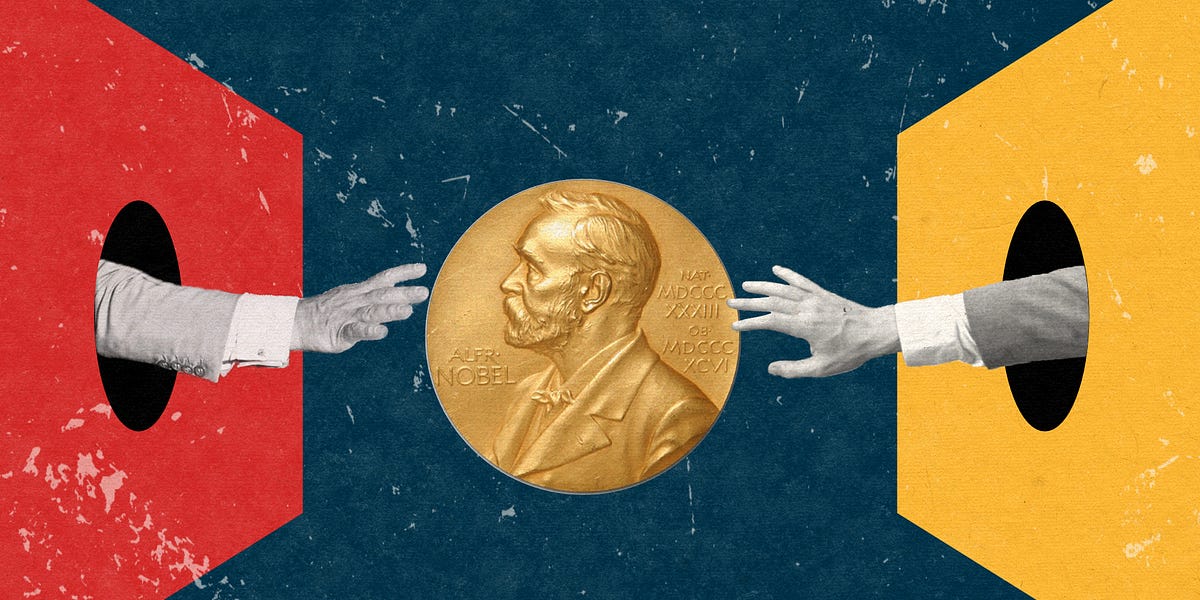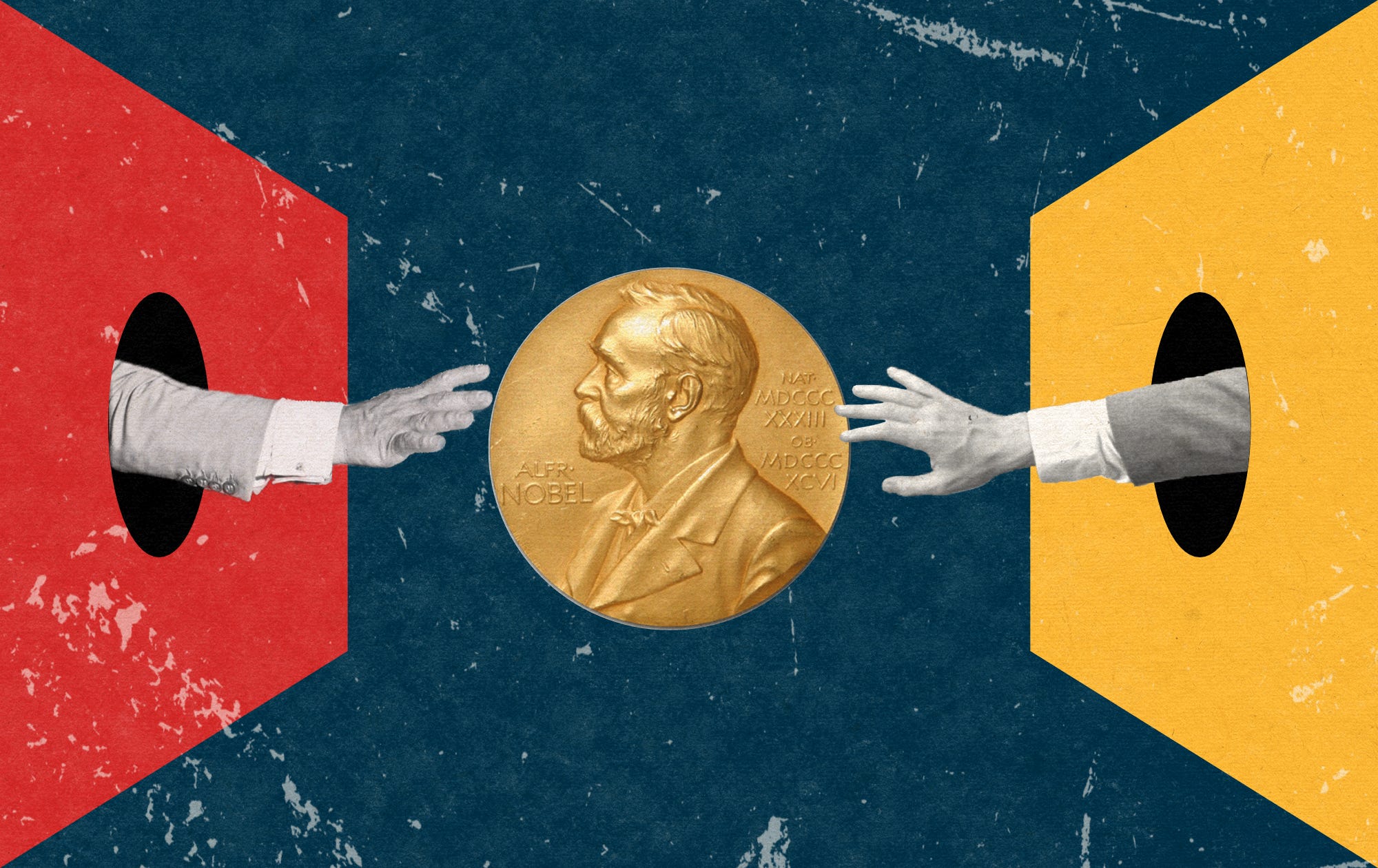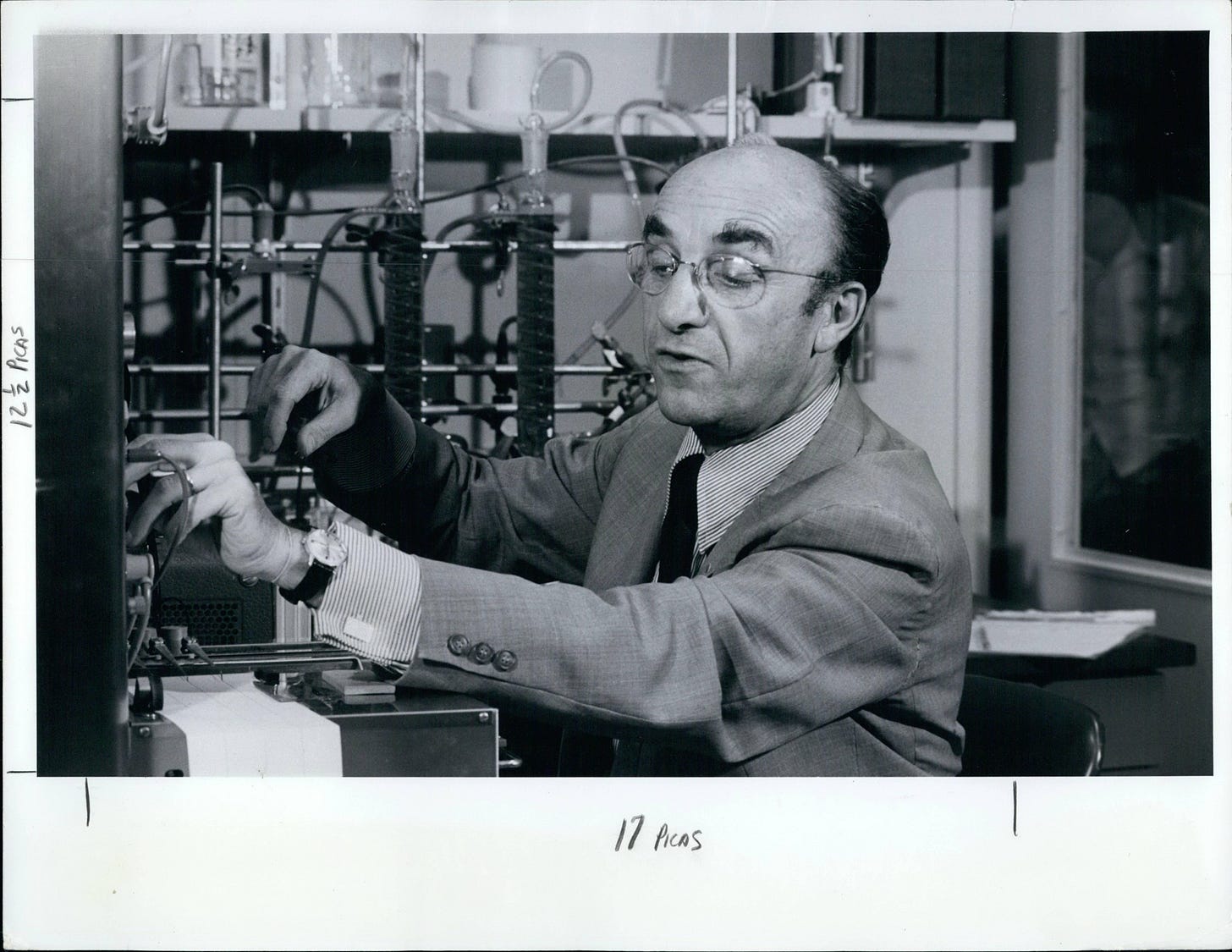We’ve begun shipping out orders for the first commercial book written and sold in both natural language and DNA. Learn more in our announcement article or click here to order.
What would you give for a Nobel Prize?
For more than a century, the Nobel has been science’s highest honor. The prize is awarded to only a few researchers per year for achievements in physics, chemistry, and “physiology or medicine.” Nobel laureates hold immense prestige and wield influence not only within their fields but also within the broader public sphere. Nearly every scientist, at some point in their career, dreams of winning a Nobel, even if just as an overconfident undergraduate student. But for some, the prize is more than merely a dream: it’s an obsession.
Published in 1981, Nicholas Wade’s The Nobel Duel recounts how endocrinologists Andrew Schally and Roger Guillemin discovered peptide hormones produced by the hypothalamus, earning each of them a 1/4 share of the 1977 Nobel Prize in Physiology or Medicine.
But more than this, Wade’s book details an intensely bitter rivalry, shaped not only by the personalities of the characters involved but by the incentives of the system in which they worked. More than forty years later, The Nobel Duel remains a valuable cautionary tale about the competitive pressures that shape scientific discoveries.
Before diving into Schally and Guillemin, it’s helpful to learn a bit about the hypothalamus, the subject of their scientific struggles. The hypothalamus is a small lump of brain tissue, about the size of a hazelnut, that sits about seven centimeters behind the nose.
Despite its small size, the hypothalamus serves an important role as a regulatory center for hormonal signaling. It controls the pituitary gland, for example, another small tissue nodule located directly underneath it. The hypothalamus responds to nerve signals from the brain and stimulates the pituitary to release hormones that act on the rest of the body. This pathway controls a wide variety of critical processes, including growth, metabolism, reproduction, and stress response. The hypothalamus plays an integral role in reproductive biology, too, controlling everything from the production of sex hormones to ovulation and the menstrual cycle.

In rabbits, where ovulation is triggered by sexual intercourse, the hypothalamus converts the neural signal (female orgasm) into a hormonal signal (luteinizing hormone release by the pituitary) causing the ovaries to release eggs. This was discovered in a set of groundbreaking experiments in the 1930s, but the mechanism remained unclear for decades. How, exactly, does the hypothalamus communicate between the brain and the pituitary?
An obvious hypothesis would be that the hypothalamus controls the pituitary via nerve signals. However, although the hypothalamus sits immediately adjacent to the pituitary, anatomists were unable to identify any nerves that could plausibly be responsible. In the 1940s and 50s, the English physiologist Geoffrey Harris conducted a set of experiments to test an alternative hypothesis: namely, that a small molecule, rather than a physical neural connection, might be responsible.
Working in rats, Harris carefully severed a set of tiny blood vessels connecting the hypothalamus and pituitary and showed that the rats stopped reproducing. Harris proposed that the hypothalamus sends its own hormones through these blood vessels, triggering the pituitary to release its own set of hormones. But until such hormones could be directly identified, many scientists met this idea with skepticism. In order to explain the regulation of all the different hormones of the anterior pituitary, Harris had to hypothesize not just one hypothalamic hormone, but a whole set of them. And after all, Occam’s Razor states that “entities are not to be multiplied without necessity.” Even for Harris, this hypothesis was a leap into the unknown.
Roger Guillemin and Andrew Schally were no strangers to stress, even early in their lives. And in an ironic coincidence, it was stress itself that sparked their acrimonious race to discover the hormones of the hypothalamus.
Guillemin, born in 1924, grew up in the French town of Dijon. The Nazi occupation interrupted his medical studies, but after the war, he found a position in Montreal, where he completed his PhD under professor Hans Selye, studying the stress response mediated by the pituitary and adrenal glands.
Unfortunately, Guillemin clashed with his advisor. As another of Selye’s students, Claude Fortier, put it, the two men were occasionally “in complete and total disagreement in our intellectual approach to research.” Although Guillemin finished his PhD in Selye’s lab, he was eager to search for a job elsewhere. In 1953, he secured an assistant professorship at Baylor College of Medicine and began setting up his own lab.
When a colleague at Baylor, professor Charles Pomerat, complained to Guillemin that pituitary cells did not produce hormones when cultured in vitro, Guillemin saw an opportunity to test Harris’ hypothesis. With the help of one of Pomerat’s students, Barry Rosenberg, Guillemin repeated the experiment. As before, the cells did not produce hormones in culture. But Guillemin took the experiment a step further, adding a piece of tissue from the hypothalamus to the culture dish with the pituitary cells. If Harris’ hypothesis was correct, the hypothalamus hormones would cause the pituitary cells to resume their own hormone production.
In particular, Guillemin noticed that ACTH, a pituitary hormone that mediates the response of the adrenal glands to stress, was only produced in the presence of hypothalamus tissue. Since no nerves were formed between the hypothalamus and pituitary cells in the cell culture, this interaction had to be hormonal. Guillemin immediately published his work, but to his consternation, he soon saw that he wasn’t the only one who had made this groundbreaking observation. As The Nobel Duel describes it, “The experience was like planting a flag at the top of Everest only to see, as the mist cleared, that another flag was being erected by somebody else.”
That somebody else was Andrzej (Andrew) Schally. Born in Wilno, Poland in 1926, Schally was the son of Kazimierz Schally, a general in the Polish Army. When Germany and Russia invaded and occupied Poland in 1939, many Polish soldiers escaped to Romania, Schally’s family among them. Andrew Schally survived the Nazi and Soviet occupations and then moved to the United Kingdom after the war, where he studied chemistry. By that time, he already displayed “a sort of manic persistence” for scientific research, his old supervisor recalled. In 1952, Schally moved to McGill University in Montreal, where he would eventually earn his PhD. Together with his advisor, professor Murray Saffran, Schally showed that samples of rat pituitary tissue cultured in vitro would produce ACTH only in the presence of a substance, which Saffran named “corticotropin-releasing factor (CRF),” found in the hypothalamus.
Schally’s study was published in the journal Endocrinology in October 1955. Guillemin’s paper was published in the following issue of the same journal. Now, suddenly, both scientists were aware of the other’s work; their race began in earnest.
Both scientists, importantly, viewed CRF as “their discovery,” and each aimed to make it the central focus of an illustrious academic career. While both had shown that a hypothalamus hormone exists, neither knew what that hormone actually was. The next step was to isolate the hormone, purify it, and determine its structure. With the molecular biology tools available in 1955, however, such a feat was much easier said than done.
Thus began a 26-year marathon.
There were three main challenges in determining the structure of CRF: the hormones are made only in minute concentrations, the hypothalamus is small, and the analytical techniques of the time were not very sensitive. Instead of developing new analytical methods, Guillemin and Schally instead mounted a straightforward, brute-force attack on CRF.
At first, the two scientists worked together, embarking on their research using “state-of-the-art” technology available to biochemists in 1955. But to describe these methods as “old-school” would be extremely charitable. The duo began by using chemical methods such as salt precipitation to try to purify CRF from puréed hypothalamus. This was similar to Edwin Cohn’s successful fractionation of blood into albumin and other proteins during World War II (a story previously told in Asimov Press). However, albumin is the most abundant protein in blood plasma, whereas CRF is present in the hypothalamus in only trace amounts.
In a biochemistry lab class as an undergraduate, I got a small taste of the difficulties these researchers faced as I labored to purify lactate dehydrogenase from beef heart using salt precipitation and Sephadex ion-exchange chromatography. Grinding up a beef heart in a blender was not a pleasant experience, and even then, I was only able to isolate less than a milligram of lactate dehydrogenase — one of the most abundant proteins in the heart. These days, it’s much easier to produce proteins by recombinant expression in bacteria, but that technology did not become available until the 1970s. So instead, Schally and Guillemin were forced to grind up literally millions of animal hypothalami, dissected from hundreds of tons of brains, and carefully separate them into their constituent molecules. Each fraction had to be assayed for hormone activity, and at first, the only way to measure this was by injecting it into animals and waiting multiple days to monitor a response.
From 1957 to 1962, Schally performed his research in Guillemin’s lab at Houston. Since Guillemin specialized in physiology and Schally in biochemistry, they formed a complementary pair. However, their search for the structure of CRF bore little fruit, and resentment began to grow between them. Guillemin was the lab head, which meant that he was able to pursue more productive avenues of research, even setting up a second lab in France and splitting his time between Paris and Houston. By contrast, Schally toiled for up to 18 hours per day on the CRF project, tediously isolating fractions without much success. As Schally saw it, “[Guillemin] wanted me to take the blame when things went wrong and to take the credit for himself when things went right … An equal partner I could be with him, but he wanted me to be his slave.”
The tipping point came at a conference in late 1961 organized by the NIH Endocrinology Study Section, a major funder of Schally and Guillemin. The endocrinologist tasked with summarizing the presentations, Roy Greep, was clearly unimpressed by the lack of progress in actually isolating and characterizing CRF, writing: “never before to my knowledge, except for the monster of Loch Ness and the Abominable Snowman of the Himalayas, has the existence of hypothetical objects been indicated by so much imposing circumstantial evidence.”
Having CRF likened to the Loch Ness Monster struck a nerve. Nearly five years had been spent, and although Schally and Guillemin had made a small amount of progress, they still had not achieved their primary aim of determining the hormone’s structure. In private letters, Schally accused Guillemin of supplying him with inadequate materials, and Guillemin responded by suggesting Schally’s poor biochemical work was to blame. Not long after, Schally began looking for other positions, eventually obtaining a job at Tulane University in New Orleans. By the end of 1962, Guillemin and Schally had publicly fallen out, and Schally started setting up his own lab.
To compete with Guillemin, Schally needed a lot of brains — and not just metaphorically. Each experiment required tens of thousands of hypothalami to isolate minute quantities of hormones. Guillemin favored sheep hypothalami and purchased well over two million of them from slaughterhouses in France over the course of his lab’s work. Schally instead opted to use pig hypothalami, for two reasons: First, by using pigs instead of sheep, if Guillemin beat him to the discovery of a hormone, Schally’s work would not be completely wasted since hormones in different species are not necessarily the same. More importantly, Schally established a plentiful source of pig brains through a connection with Oscar Mayer, the meat-packing company that slaughtered ten thousand pigs per day. In the end, Schally’s work on the hypothalamic hormones would consume more than one million pig hypothalami, provided by Oscar Mayer free of charge.
With Guillemin and Schally now leading separate laboratories, a vicious competition began. In the beginning, both men had focused on CRF, since it was the only hypothalamic hormone for which a good measurement assay was known. However, five years of unsuccessful attempts to determine the structure of CRF had convinced both to seek an easier target. Shortly after Schally left his lab, Guillemin made an important advance by developing an accurate assay for thyrotropin releasing factor (TRF), a hormone that coaxes the pituitary to release thyroid stimulating hormone (TSH). The new assay opened up TRF as a target for isolation, starting a race to characterize its structure in addition to CRF.
Although Guillemin had a head start in this race, he was unable to maintain his early lead. Solving the structure of TRF was basically a biochemical problem, and since Guillemin was not a biochemist himself, he relied on others to perform the experiments. Despite their help, though, Guillemin looked down on the biochemists he worked with, neglecting to properly credit them for their work. This “inability to work with others on an equal basis” was what drove away not only Andrew Schally but also a succession of biochemists — first Marian Jutisz (who performed much of the initial work on TRF) and, later, Wylie Vale and Roger Burgus, two of Guillemin’s star proteges. Guillemin also clashed with administrators at the Collège de France, which led him to move all his work back to Houston. Meanwhile, in New Orleans, Schally was busy grinding up pig hypothalami. His goal was simple: to prepare a sufficient quantity of pure TRF for structural determination. But in practice, this was deceptively complex.
After four years of painstaking work, Schally and Guillemin had both nearly succeeded, but astonishingly, both made the same wrong turn, erroneously concluding that TRF is not a peptide due to faulty experiments.
Guillemin’s laboratory, for example, extracted TRF molecules from 500,000 sheep, but found that it only contained 8 percent amino acids by mass. Unaware of his mistake, Guillemin trumpeted this result as a breakthrough. Schally came closer but still missed the mark. He found three amino acids in his hypothalami — histidine, glutamic acid, and proline — but was unable to determine the sequence in which they were linked, and worse, falsely concluded that they made up only 30 percent of the TRF molecule. With the remaining 70 percent unknown, Schally could only guess at the molecule’s identity. (It’s now known that TRF is a peptide, meaning it is made entirely of amino acids.)
Throughout this time, both labs were not only busy with science but also with undermining each other. They would slight each other at conferences, downplay each other’s contributions in review articles, refuse to share materials, and send passive-aggressive letters. After a conference at which Guillemin had allegedly disparaged Schally, Schally wrote: “Your somewhat derogatory and deprecating remarks . . . surprised me as the attack on Pearl Harbor surprised the U.S. Navy”.
Guillemin replied with a calculated riposte: “I have no comments except to say that I am neither your conscience nor your psychiatrist.”
Overall, it appears that Guillemin took up a strategy of s




